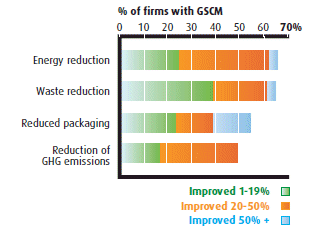Environmental Benefits of GSCM Practices
Most logistics and transportation service providers that implement GSCM practices see improvements inboth energy and waste reduction as well as decreased packaging within distribution activities (Figure 4).
Figure 4: Environmental improvements stemming from GSCM practices in distribution activities1

For example, energy reduction can be achieved by employing anti–idling technology and introducing electric hybrid vehicles in distribution activities. Improved oil and toxic material recycling programs benefit theenvironment by reducing excess waste and water contamination. Additionally, using reusable crate materialcan decrease the amount of packaging and delivery material waste. All such changes have proven to reducea business' carbon footprint and save considerably on distribution costs.2
